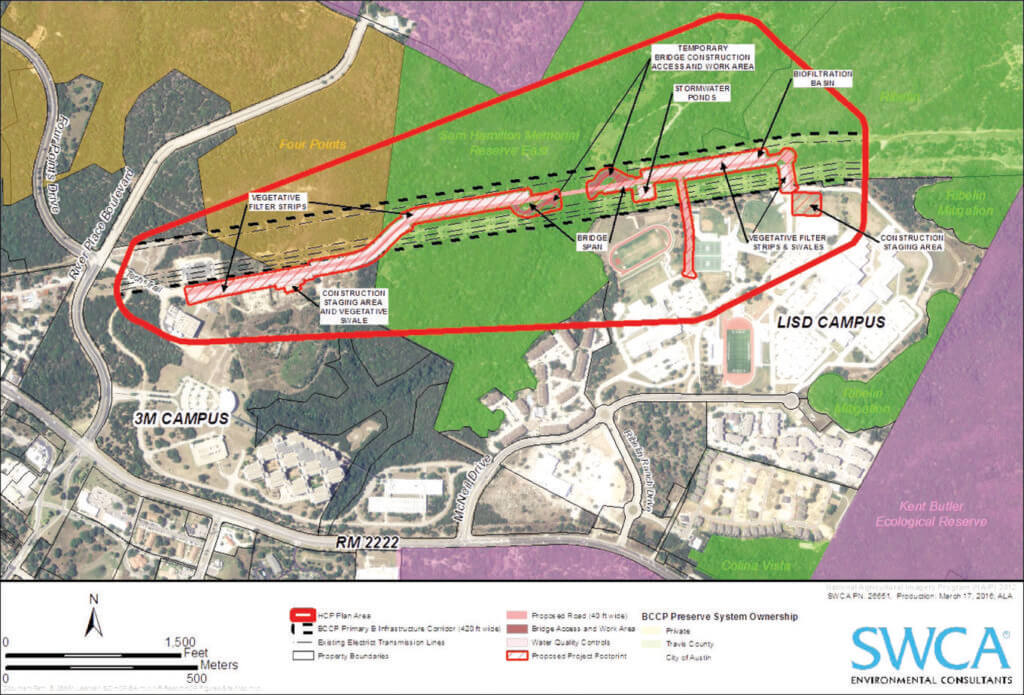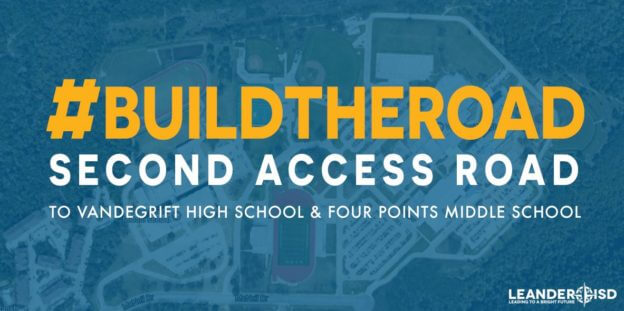
The second access road behind Vandegrift would cost over $15 million and be one mile with a 100-foot right of way and an 800-foot bridge to protect habitat below.
Launches #BuildTheRoad campaign
By LYNETTE HAALAND
Four Points News
Leander ISD is seeking the community’s involvement and support in its biggest push to build a second access road to Vandegrift. It launched the #BuildTheRoad social media campaign last week in an effort to get Washington D.C. lawmakers’ attention on the proposed one-mile, $15 million-plus road.
At its public forum at VHS on May 30, LISD reminded the audience of the proposed second access road that LISD and the Four Points Traffic Committee has been working on since February 2013.
More than 3,700 students and staff use VHS and Four Points Middle School and currently, the only road into and out of those campuses is off of McNeil Drive. That leads to a bottleneck of traffic especially at the intersection of RM 2222.
A second access road would positively impact student safety, would improve traffic efficiency, would be built along an existing infrastructure corridor, would have minimal environmental impact, and would be the safest option for the community, which also includes apartments and Austin Baptist Church.
The project would cost an estimated $15 million – $17 million, said Jimmy Disler, LISD chief facilities and operations officer.
Over the past several weeks, LISD and the Four Points Traffic Committee have contacted Texas representatives in Washington to request that the U.S. Fish and Wildlife Service work with them to find viable solutions for the road.
“Approval comes from the federal government,” said LISD Superintendent Dan Troxell. “It sounds like daunting task but there is power in numbers.”
That is why LISD is asking for the community’s help in reaching lawmakers. Troxell asked that attendees spread the word and encourage at least two more people to take action. Handouts at the forum and information on the LISD website provide example posts and letters, phone numbers and mailing addresses.
“We’re asking you to take the time to contact these lawmakers over these next couple of weeks — on social media, by writing a letter or email, by calling their office — to request that the U.S. Fish and Wildlife Service work with LISD to find a solution,” Troxell said.
The USFWS’s help is needed on this because VHS and FPMS are surrounded by preserve lands which include the federally endangered black-capped vireo and golden-cheeked warbler and the federally threatened Jollyville Plateau salamander.
The proposed secondary access road would run through the preserve land and along an existing infrastructure corridor where there are city of Austin and Lower Colorado River Authority utility lines. The road would also run along a small portion of land that 3M owns, and 3M supports the road, Disler said.
“We’re only asking for part of the corridor to build the road. There is a 420-foot wide corridor, we’re asking about 40 feet,” Troxell said. “We would need to build a bridge over Bull Creek. We would like to have sidewalks.”
The project would include approximately one mile of road with a 100-foot right of way and an 800-foot bridge to protect habitat below.
“We don’t want to disturb or cause a problem with the environment,” Troxell said.
Pamela Waggoner, vice president of the school board and founder of the Four Points Traffic Committee, said there is more movement now than there has ever been on this initiative.
“This is our last big chance effort. If community doesn’t get involved, this is it,” Waggoner said.
The Four Points Traffic Committee first proposed an alternative road years ago which was backed by LISD. The efforts had stalled out at the local level so the committee and LISD chose to seek help from Washington.
More details of the public forum and social media campaign with sample letters and tweets can be found at www.leanderisd.org and on the Four Points Traffic Committee’s Facebook page.


